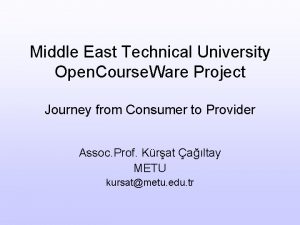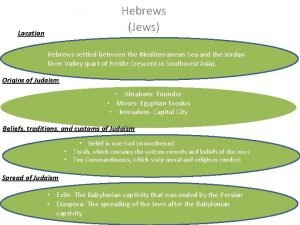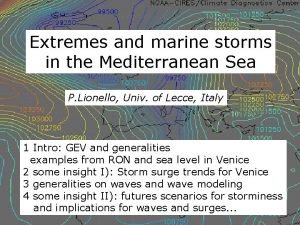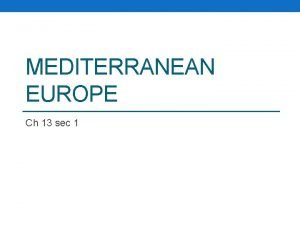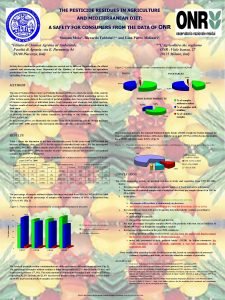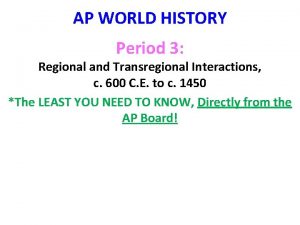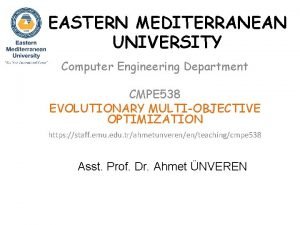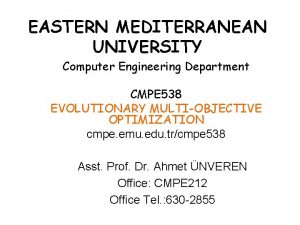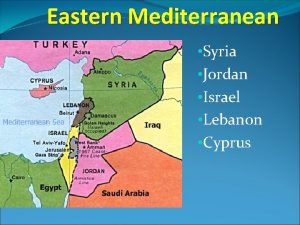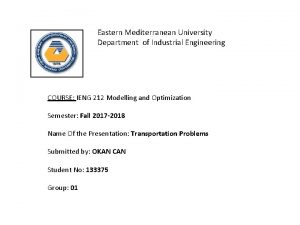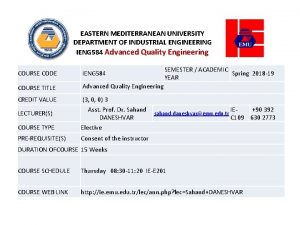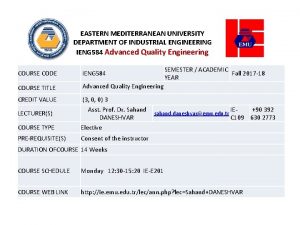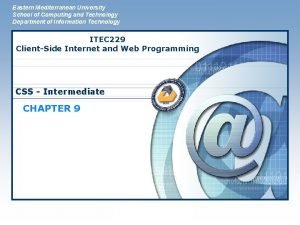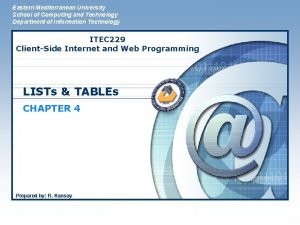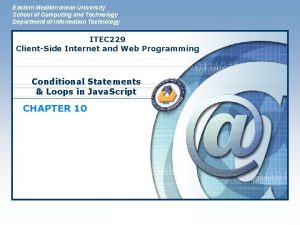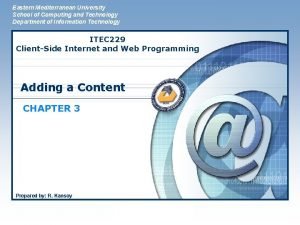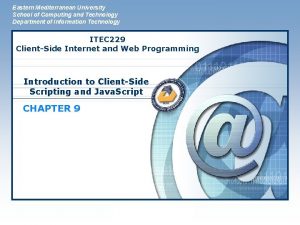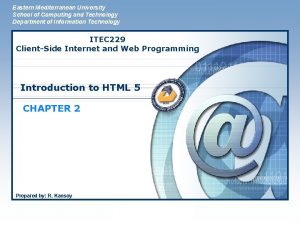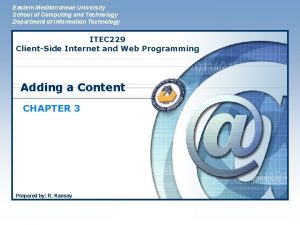Eastern Mediterranean University Department of Computer and Instructional




























- Slides: 28

Eastern Mediterranean University Department of Computer and Instructional Technology Teacher Education ITEC 106 1

Instructional Approaches 2

What is Flipped Classroom • The term flipped classroom was popularised by teachers Aaron Sams and Jon Bergman from Woodland Park High School, Colorado in 2007 in response to a realization that class time would be best spent guiding knowledge and providing feedback rather than delivering direct instruction. • The flipped classroom is a pedagogical model in which the typical lecture and homework elements of a course are reversed. • Short video lectures are viewed by students at home before the class session, while in-class time is devoted to exercises, projects, or discussions. 3

What are the key elements of the flipped classroom? 1. Provide an opportunity for students to gain first exposure prior to class. 2. Provide an incentive for students to prepare for class. 3. Provide a mechanism to assess student understanding. 4. Provide in-class activities that focus on higher level cognitive activities. 4

ADVANTAGES OF FLIPPED CLASSROOM 1. Students have more control 2. It promotes student-centered learning and collaboration 3. Lessons and content are more accessible (provided there is tech access) 4. Access = easier for parents to see what’s going on 5. It can be more efficient 5

DISADVANTAGES OF FLIPPED CLASSROOM 1. It can create or exacerbate a digital divide 2. It relies on preparation and trust 3. There is significant work on the front-end 4. Not naturally a test-prep form of learning 5. Time in front of screens–instead of people and places–is increased 6

WHAT IS BLENDED LEARNING • Blended courses (also known as hybrid or mixedmode courses) are classes where a portion of the traditional face-to-face instruction is replaced by web-based online learning. • Blended learning is an education program (formal or informal) that combines online digital media with traditional classroom methods. It requires the physical presence of both teacher and student, with some element of student control over time, place, path, or pace. 7

Blended Learning Models Due to its modular design, blended learning can come in numerous shapes and sizes and be personalized to fit the individual. These types of modals can include: • Online – Instruction occurs via an online platform, with periodic face-to-face meetings. • Rotation: Student rotates between self-paced online learning and face-to-face instruction. Schedules are fixed but flexible. • Flex: Most instruction is delivered online, with teachers providing as needed support in small-group settings. • Personalized blend: Teacher designs face-to-face and anywhere, anytime learning options that straddle the physical classroom and virtual spaces. Learning is the constant and time is the variable. 8

Blended Learning Models • Online lab: Instructions takes place in a brick and mortar lab. Delivered by an online teacher and supervised onsite by paraprofessionals. • Self-blend: Students take online courses to supplement their tradition schools face to face course catalogue. • Face-to-face: Teacher offers primarily face-to-face instruction, supplemented with technology in the classroom or computer lab. 9

BLENDED LEARNING ADVANTAGES 1. Provides personalized training experiences. 2. Offers 24/7 access to training resources. 3. Track employee performance and skill development. 4. Reduction in training costs. 5. Advanced collaboration tools. Online discussions, quick messages and feedback from the instructor and peer students. 10

BLENDED LEARNING DISADVANTAGES 1. Ineffective use of learning technology tools can waste resources. 2. Learners must have basic technology knowledge or a willingness to learn. 3. High technology set up and maintenance costs. 11

PROBLEM BASED LEARNING (PBL) Problem-based learning (PBL) is a studentcentered pedagogy in which students learn about a subject through the experience of solving an openended problem found in trigger material. . It is focused on the student's reflection and reasoning to construct their own learning. 12

AN OPERATIONAL DEFINITION OF PROBLEM-BASED LEARNING IS AS FOLLOWS: 1. First students are presented with a problem 2. Students discuss the problem in a small group PBL tutorial. They clarify the facts of the case. They define what the problem is. They brainstorm ideas based on the prior knowledge. They identify what they need to learn to work on the problem, what they do not know (learning issues). They reason through the problem. They specify an action plan for working on the problem. 3. Students engage in independent study on their learning issues outside the tutorial. The information sources they draw on include: library, databases, the web and resource people 4. They come back to the PBL tutorial (s) sharing information, peer teaching and working together on the problem 5. They present and discuss their solution to the problem 6. They review what they have learnt from working on the problem. All who participated in the process engage in self, peer and tutor review of the PBL process and each person’s contribution to that process. 13

Advantages of Problem-Based Learning 1. Development of Long-Term Knowledge Retention 2. Use of Diverse Instruction Types 3. Continuous Engagement 4. Development of Transferable Skills 5. Improvement of Teamwork and Interpersonal Skills 14

DISADVANTAGES OF PROBLEM-BASED LEARNING 1. Potentially Poorer Performance on Tests 2. Student Unpreparedness 3. Teacher Unpreparedness 4. Time-Consuming Assessment 5. Varying Degrees of Relevancy and Applicability 15

WHAT IS INFOGRAPHIC? • An infographic (like the one below) is a popular form of content marketing that can help you simplify a complicated subject or turn an otherwise boring subject into a captivating experience. Ideally, an infographic should be visually engaging and contain a subject matter and data that is appealing to your target audience. • People use infographics to quickly communicate a message, to simplify the presentation of large amounts of data, to see data patterns and relationships, and to monitor changes in variables over time. 16

ADVANTAGES OF INFOGRAPHICS • 1. It is much easier and quicker to understand. You can convey a message in only a few seconds, in comparison with a text that you will need some minutes. Scientists found that people can remember the 83% of what they see, and only the 20% of what they read! • 2. Information is more definite. Pictures are clear-cut and to the point, in comparison with words that leave room for speculation. Infographics that are created for small companies which sell a product is mandatory! • 3. Boost marketing leads. It supports inbound marketing and no manual customer acquisition is required. • 4. Boost traffic. If the content of your infographic is high quality, then it is almost certain that not only it will drive traffic, but it will boost your company’s expertise/authority. 17

DISADVANTAGES OF INFOGRAPHICS 1. Time Consuming. In order to achieve a very good Infographic, your designer needs to spend some time. The creation is not the time consuming part, but the idea and the topic of the infographic is mostly the hard part! 2. Not SEO Friendly. This is not necessarily a bad thing, but it will not boost your website from SEO perspective. 3. Might get costly. Since a lot of time is required to create it, you will have to pay a lot for it! 4. Will it be valuable? Creating an infographic is one thing, promoting is a different one. You need to make sure to promote it, else you will spend your money for nothing! 18

WHAT IS PROJECT-BASED LEARNING • Project Based Learning is a teaching method in which students gain knowledge and skills by working for an extended period of time to investigate and respond to an authentic, engaging and complex question, problem, or challenge. • In Standard PBL, projects are focused on student learning goals and include Essential Project Design Elements: – Key Knowledge, Understanding, and Success Skills - The project is focused on student learning goals, including standards-based content and skills such as critical thinking/problem solving, communication, collaboration, and self-management. – Challenging Problem or Question - The project is framed by a meaningful problem to solve or a question to answer, at the appropriate level of challenge. 19

– Sustained Inquiry - Students engage in a rigorous, extended process of asking questions, finding resources, and applying information. – Authenticity - The project features real-world context, tasks and tools, quality standards, or impact – or speaks to students’ personal concerns, interests, and issues in their lives. – Student Voice & Choice - Students make some decisions about the project, including how they work and what they create. – Reflection - Students and teachers reflect on learning, the effectiveness of their inquiry and project activities, the quality of student work, obstacles and how to overcome them. – Critique & Revision - Students give, receive, and use feedback to improve their process and products. – Public Product - Students make their project work public by explaining, displaying and/or presenting it to people beyond the classroom. 20

21

*Project-based Learning VS. Problem-based Learning* 22

WHAT IS DISTANCE LEARNING? • Distance learning is a way of learning remotely without being in regular face-to-face contact with a teacher in the classroom. In the UK such learning has its roots in students learning through correspondence courses. • Distance learning allows students to study most or all of their course without attending a campus-based institution. The students communicate with faculty and other students via e-mail, electronic forums, video-conferencing, chat rooms, bulletin boards, instant messaging and other computer-based communication. 23

ADVANTAGES OF DISTANCE LEARNING 1. Provides for an increase in Access to education for those who otherwise have no other opportunities due to work, family or physical limitations. 2. Provides for a modality of instruction better suited for certain learners. 3. Greater flexibility for scheduling learning-Students can determine time and place of "class-time". 4. Greater flexibility in location for study-Students can engage course at home or work or on campus or at a library. 5. Distance Education is Learner Centered -DE places responsibility for learning with the learner who must be more active and self directed. 6. Facilitates greater learner-instructor interaction. 7. Increased interaction with classmates. 8. Facilitates Pedagogic Development-Individual Instructor Development. 9. Produces a carry over effect into the regular classroom of improved pedagogic techniques. 24 10. Opportunity to develop technology competencies for instructors and learners.

DISADVANTAGES OF DISTANCE LEARNING 1. Time and frustration involved learning how to get on-line for novices. 2. Lag time between student input and feedback -Time lapse between need for learner support and resolution. 3. Occasional internet provider downtime. 4. Student must be more active and self-directed in learning environment Depends on individual motivation and initiative. 5. Occasional feelings of isolation- Potentially less group support for learners leading to isolation and possible non-completion of program. 6. Instructional design for group activities and group interaction more demanding on the instructor. 7. Demands large effort and cost to develop appropriate materials. 8. Demands large effort to create and maintain the technological infrastructure. 9. Distance Education is not for everyone. - It is not for undisciplined learners nor inflexible instructors. 25

WHAT IS GAME-BASED LEARNING • Game-based learning (GBL) is a type of game play that has defined learning outcomes. Generally, game-based learning is designed to balance subject matter with gameplay and the ability of the player to retain, and apply said subject matter to the real world. 26

ADVANTAGES OF GAME-BASED LEARNING 1. Using games in the classroom lends itself to engaging the learners as well as creates an environment of experiential learning 2. The interaction in these games creates a better understanding for the learners in regards to information, tools, materials, and even the other learners. 3. Creates an “Engaged Learning Design” 4. Creates an environment that can analyze the perspective, narrative, and interactivity of the learners amongst one another 27

DISADVANTAGES OF GAME-BASED LEARNING 1. Creates a series of developmental challenges for the learners 2. Game culture and play could be a disadvantage to the learner if not designed correctly 28
 Chapter 16 eastern mediterranean answers
Chapter 16 eastern mediterranean answers Computer science department columbia
Computer science department columbia Eku aviation
Eku aviation University of eastern colorado firewatch
University of eastern colorado firewatch Odtü open course
Odtü open course Sic machine architecture
Sic machine architecture The hebrews settled between the mediterranean sea and the
The hebrews settled between the mediterranean sea and the Tum
Tum Settlement patterns
Settlement patterns Mediterranean diet pyramid oldways
Mediterranean diet pyramid oldways Make everyday mediterranean
Make everyday mediterranean Africa mediterranean
Africa mediterranean Storms in the mediterranean sea
Storms in the mediterranean sea Dash diet vs mediterranean
Dash diet vs mediterranean Greek colonies in the mediterranean
Greek colonies in the mediterranean Ancel keys mediterranean diet
Ancel keys mediterranean diet Mediterranean civilizations location hemisphere
Mediterranean civilizations location hemisphere Mediterranean shipping cruises
Mediterranean shipping cruises Chapter 13 section 1 mediterranean europe
Chapter 13 section 1 mediterranean europe Lesson 4 the jews in the mediterranean world
Lesson 4 the jews in the mediterranean world Function of lenticels
Function of lenticels Mediterranean diet pesticides
Mediterranean diet pesticides Bioluminescence mediterranean sea
Bioluminescence mediterranean sea Veronica v picasso biografia
Veronica v picasso biografia Mediterranean sea map
Mediterranean sea map Danube river physical map
Danube river physical map General fisheries commission for the mediterranean
General fisheries commission for the mediterranean Mediterranean island nation
Mediterranean island nation Car gurtus
Car gurtus




